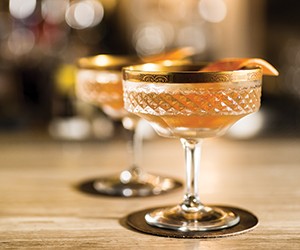In Hong Kong, fusion cuisine takes on a whole new meaning. With a flourishing art scene and established dining scene, the two elements are increasingly being paired. Throughout the city, various fine-dining restaurants have merged art and food by offering an eclectic collection of art as part of their decor and utilizing the artwork as inspiration for the dishes.
“The art/dining trend is continuing to grow and we can anticipate that more restaurants will catch on and even new restaurants built with that theme in mind,” says Bill Flora, U.S. director of the Hong Kong Tourism Board.
One of the establishments that combines the two, Michelin-star restaurant Duddell’s, spotlights Cantonese cuisine by renowned chef Siu Hin Chi. Located in the Shanghai Tang Mansion in Hong Kong’s Central district, Duddell’s features a year-round art program with curated art shows, art talks, performances, film screenings and other cultural events. Duddell’s is spread across two levels and includes a traditional Cantonese restaurant and cultural salon, with its adjacent 2,000-square-foot outdoor space occupying the third and fourth floors of the building and open to groups.
Another dining spot integrating art into its repertoire, Bibo melds contemporary and street art with upscale French cuisine. The menu features home-made items, from its bread to the ice cream. Behind the bar, mixologist Alexandre Chatte creates a menu of 1930s-era handcrafted cocktails. Artworks include a sculpture by Japanese artist Takashi Murakami, a wooden installation by New York-based Kaws and a scooter with the calligraphy of once-famed graffiti artist Tsang Tsou Choi, aka the King of Kowloon.
The Popsy Room, a multisensory gallery situated on Hollywood Road’s art trail, offers a reservation-only gastronomic experience through an in-house chef pairing food with art. Located in Sheung Wan’s Upper Lascar Row, or Cat Street, Popsy sits among antique dealers, curio merchants, art galleries and small eateries. The venue serves as a platform for artists to use various mediums, including sounds, sights, tastes and aromas, everything from painting and photography to animation and multimedia.
The China Club is designed with a strong sense of tradition and history, with motifs widely used in Hong Kong and Shanghai in the 1930s and 1940s. The Club contains paintings and sculptures by Chinese artists from China, Taiwan and Hong Kong. It offers traditional Chinese food, ranging from home cooking to haute cuisine.




